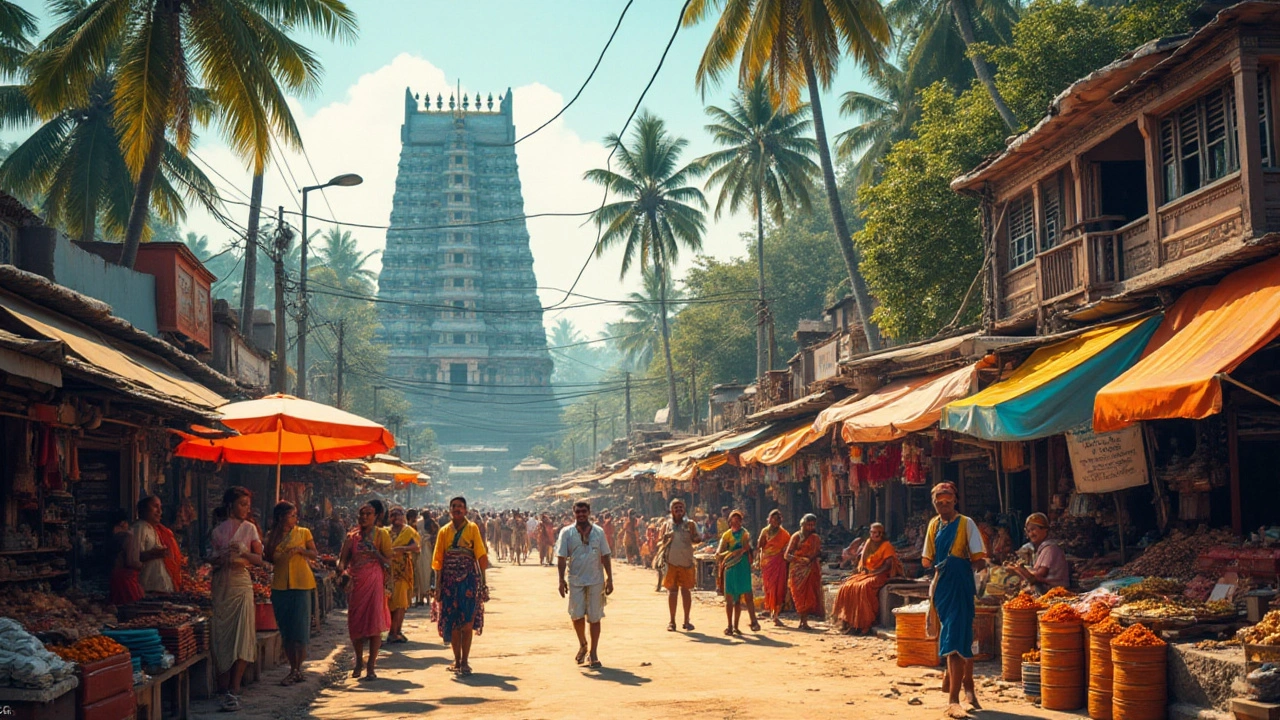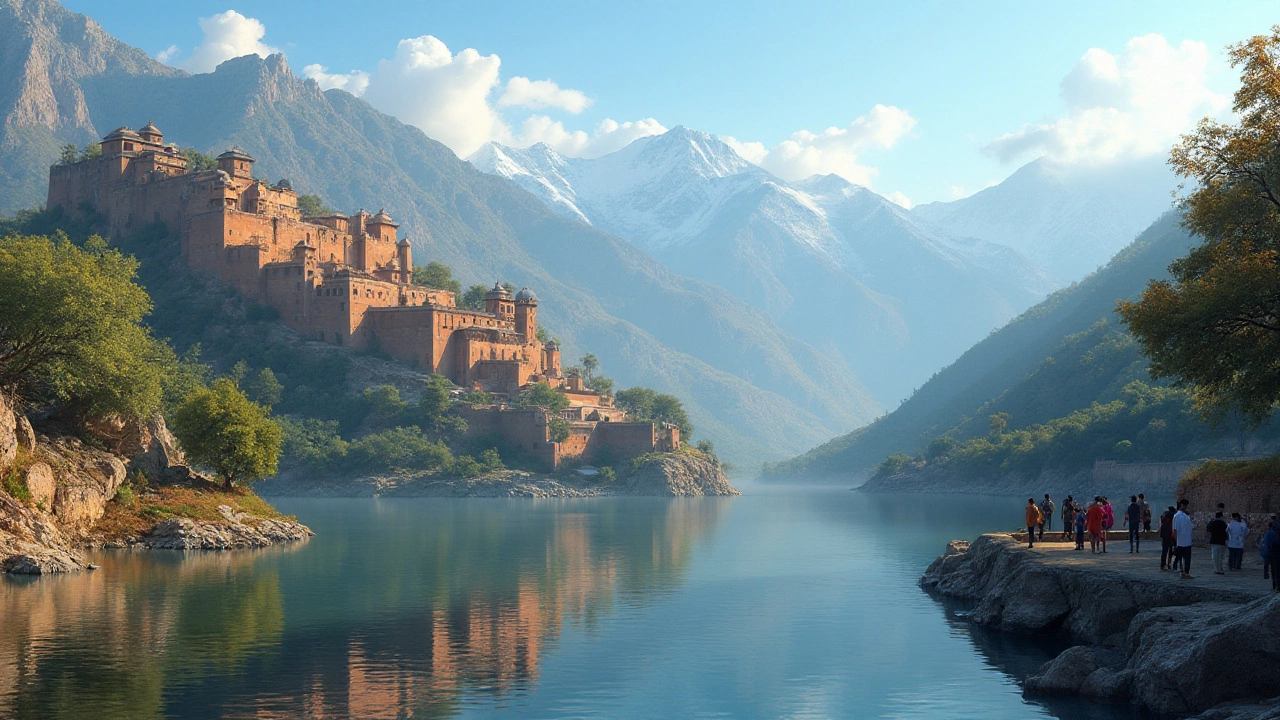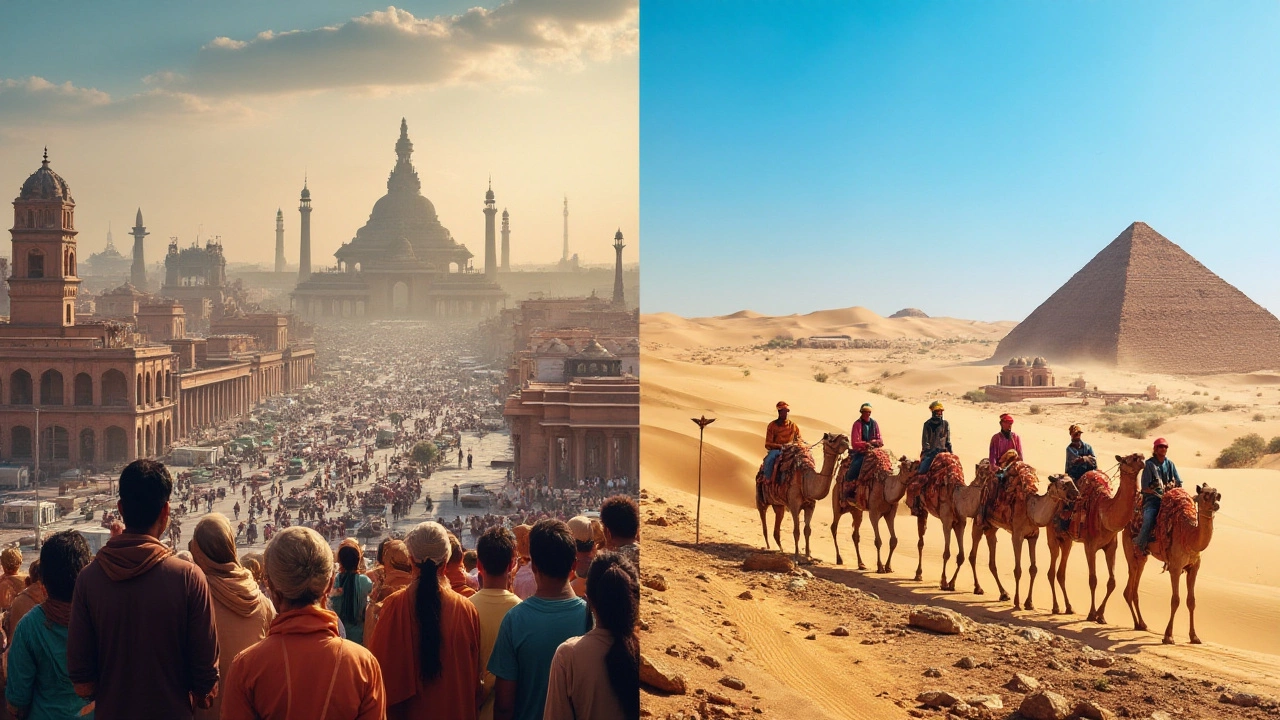Exploring the Wealth of South vs North India in Tourism
 Jan, 22 2025
Jan, 22 2025
When it comes to exploring India's richness, both South and North India present a tapestry of vibrant cultures, historical landmarks, and enchanting natural beauty. The economic narratives of these regions are as diverse as their landscapes, influencing their respective tourism industries.
For the curious traveler, understanding these distinctions offers a deeper insight into not only where to go, but what each place uniquely offers. From lush backwaters and ancient temples in the South to the majestic Himalayas and bustling bazaars of the North, each region boasts its own charms.
Let’s navigate through these regions' economic backdrops, explore their magical sights, and offer some practical travel tips for your adventurous soul. Immerse yourself in the incredible diversity of India's tourism landscape.
- Regional Economic Differences
- Tourist Attractions in South India
- North India's Wonders
- Cultural Richness and Heritage
- Travel Tips and Suggestions
Regional Economic Differences
The intricate economic tapestry of South India and North India paints a compelling picture of contrasts and complementarities that enrich the tourism landscape. South India, with its bustling IT hubs, thrives on technology-led industries. Home to cities like Bengaluru, Chennai, and Hyderabad, the region has established itself as a powerhouse of innovation and business. This economic vitality naturally spills over into a tourism sector that benefits from an influx of business travelers and the development of luxury accommodations and retreats that cater to these frequent flyers. The vibrant commerce scenes in these cities often make contrasting companions to the serene temple towns and the plentiful lush backwaters dotted across their expanse.
North India, on the other hand, tells a story steeped in historical grandeur, where the remnants of ancient empires fuel its economic narrative. The North is famous for the fertile plains benefitting agriculture, which remains a significant part of its economy. Cities like Delhi, Agra, and Jaipur form part of the ‘Golden Triangle’, attracting tourists with their imperial legacies, bustling artisan markets, and culinary delights. This region's economy is as much built on showcasing its past as it is on embracing the bustling energy of its present. The tourism treasure trove here is unmatched, drawing visitors who marvel at the legendary Taj Mahal, explore the majestic forts, and wander through the colorful festivals that testify to the region's dynamic cultural spectrum.
"The economic backbone of North and South India is molded by their unique historical and geographical factors," says renowned historian Rajiv Katyal. "While South India rides high on technological advancement, North India's wealth of history adds an invaluable layer to its economic framework."
Economic Contributions to Tourism
The economic prowess of these regions undoubtedly shapes their tourist offerings, feeding into an ecosystem that thrives on diversity. South India's focus on IT and education has led to superior infrastructure, making it easier for travelers to navigate, while also enriching the cultural tapestry with a cosmopolitan flair courtesy of an international tech crowd. As a result, one finds state-of-the-art convention centers alongside tranquil escape resorts nestled in lush landscapes.
The tourism economy of North India leans heavily on its cultural affluence. Visitors come to be enveloped in the stories told through its ancient architecture and monuments. The thriving bazaars here reflect an economy alive with craftsmanship, with textiles, jewelry, and handicrafts playing a key role in sustaining the livelihoods of many. This blend of economic activities allows both regions to offer unique attractions, inviting tourists not just to see India but to experience all its contrasts.
Statistical Insights: South vs North
To underscore these regional differences, consider the following comparison:
| Factor | South India | North India |
|---|---|---|
| Major Industries | IT, Textiles, Automotive | Agriculture, Tourism, Handicrafts |
| Top Tourist Sites | Kerala Backwaters, Mysore Palace, Mahabalipuram | Taj Mahal, Jaipur Forts, Varanasi Ghats |
| Economic Focus | Technology and Modern Industries | Heritage and Culture |
The diversity of economies across South India tourism and North India travel displays how each region can appeal to different interests and preferences. Whether one is seeking a modern getaway enriched by technology and commerce, or a cultural odyssey through history-laden cities, each region offers a wealth of experiences, making them both essential destinations in their own right.
Tourist Attractions in South India
South India is a treasure trove of stunning landscapes, ancient architecture, and vibrant cultures that beckon tourists from around the globe. The region is known for its unique ability to blend tradition with the present, creating a magnetic pull for anyone craving an immersive experience. Touted for its rich heritage and lush environments, exploring this part of India can feel like traversing a colorful tapestry of history and nature, where every city and village has its own story to tell.
A prominent highlight of South India tourism is its plethora of temples, each carving out a chapter in the annals of Indian architecture. The Meenakshi Temple in Madurai, with its towering gopurams covered in vivid sculptures, attracts art and history lovers. Built during the Dravidian era, this architectural marvel is not just a religious enclave but a hub of cultural activities where dance and music festivals often take place. Similarly, the majestic Brihadeeswarar Temple in Thanjavur stands as a pinnacle of Chola Empire's architectural brilliance, drawing visitors with its awe-inspiring carvings and enormous structure.
Nature enthusiasts often find solace in the serene backwaters and pristine beaches of Kerala. Known as 'God's Own Country', Kerala offers enchanting houseboat cruises on the backwaters of Alappuzha and Kumarakom, where tourists can unwind amidst lush greenery and tranquil waters. The beaches of South India, such as those in Goa and Kovalam, present the perfect blend of relaxation and adventure, with opportunities for water sports, sunbathing, and enjoying the vibrant local culture. Anil Kumar, a well-known travel writer, states, "The allure of Kerala’s backwaters is unmatched; it’s a journey where the world feels both still and boundless."
The South is not just about temples and beaches; it's also about rolling hills and exotic wildlife. The Western Ghats, home to Hill Stations like Munnar, Ooty, and Coorg, offer breathtaking vistas and a refreshing climate. These destinations serve as an escape from the tropical heat and provide excellent opportunities for trekking, bird watching, and connecting with nature. Plantation tours, particularly of tea and coffee, are popular here, allowing tourists to delve into the lush landscapes south India is known for.
Moreover, South India boasts vibrant cities like Bengaluru and Chennai, which are tech-savvy hubs pulsating with youthful energy and innovation. These modern metropolises are steeped in cultural festivities and traditional practices, seamlessly blending the new with the old. Bengaluru’s flowering purple jacaranda trees and lively pub scene offer a stark, yet harmonious, contrast to the timeless markets and spiritual sites that dot the city streets.
Here's a small table showcasing some must-see attractions and their uniqueness:
| Attraction | Unique Feature |
|---|---|
| Meenakshi Temple | Dravidian architecture, intricate sculpture work |
| Kerala Backwaters | Traditional houseboats, tranquil beauty |
| Munnar | Tea plantations, cool climate |
| Goa Beaches | Lively beach culture, water sports |
| Bengaluru | Tech hub, vibrant nightlife |
Whether it's strolling through a coffee plantation in Coorg, meditating at an ashram in Pondicherry, or enjoying a cultural performance in Chennai, the mosaic of experiences in South India is both vast and deeply enriching. This region ensures that every traveler leaves with stories to tell and memories that linger long after the journey ends.

North India's Wonders
North India, a region teeming with historical grandeur, offers a plethora of wonders that captivate any traveler's heart. The towering snow-capped peaks of the Himalayas provide not just a stunning backdrop for photography enthusiasts but also a spiritual solace to those seeking tranquility. Adventure seekers flock to these rugged terrains for trekking, paragliding, and skiing, each experience bringing them closer to nature's awe-inspiring beauty. The region is also home to the iconic Taj Mahal, a UNESCO World Heritage site, which stands as a testimony to India's rich cultural tapestry and architectural brilliance. Often described as a ‘teardrop on the cheek of time,’ its marble facade mesmerizes visitors from around the globe, proving to be a timeless emblem of love and artistry.
The bustling capital city of Delhi seamlessly blends the old with the new. From the intricate carvings on the walls of its Red Fort to the expansive boulevards surrounding India Gate, Delhi's landscape stands as a living chronicle of the nation's history. A walk through Chandni Chowk, one of the oldest and busiest markets in Delhi, is an explosion of colors and aromas, offering everything from spices to jewelry. Moreover, the sacred River Ganges, flowing through cities like Varanasi and Haridwar, holds a deep spiritual significance. Witnessing the Ganga Aarti, an evening prayer ritual performed on the river banks, is an otherworldly experience, leaving an indelible mark on the soul.
“To my mind, the greatest reward and luxury of travel is to be able to experience everyday things as if for the first time.” – Bill Bryson
The North is not without its natural parks and wildlife sanctuaries. Jim Corbett National Park, the oldest in India, provides an ideal habitat for its diverse fauna, including the majestic Bengal tiger. Wildlife safaris offer a thrilling opportunity to spot these magnificent creatures along with elephants and a variety of bird species. The region's cultural diversity is further showcased in its art, music, and festivals. Rajasthan’s vibrant festivals, like Diwali and Holi, add a splash of color to its arid landscape, inviting visitors to partake in the joyous celebrations.
Whether you're exploring the exquisite palaces of Jaipur, the spiritual havens in Amritsar, or the lush valleys of Kashmir, North India unfolds a myriad of experiences that are both profound and delightful. Tourists are advised to dress modestly to respect local cultures and make the most of their visit by planning their travel around major festivals or cultural events. Each part of this region tells a story through its landscapes, people, and monuments, promising an unforgettable journey full of memorable encounters and newfound inspirations.
Cultural Richness and Heritage
India's cultural fabric is a breathtaking mosaic, with both South India tourism and North India providing captivating threads in this intricate tapestry. Starting with South India, a region renowned for its spiritual depth and historical resonance, one can embark on a journey through time. The ancient temples of Tamil Nadu, such as the Brihadeeswarar Temple, not only serve as places of worship but as canvases of astonishing art. These temples capture the architectural genius of the Chola dynasty through their towering gopurams and detailed stone carvings. Karnataka, with its expansive Vijayanagara ruins at Hampi, tells tales of grandeur and imperial might, while Kerala serves as the cradle of classical art forms like Kathakali and Mohiniyattam, mesmerizing visitors with age-old artistry.
Switching lanes to North India, a treasure trove of varied cultural experiences and historic splendor awaits. Here lies the indomitable Taj Mahal in Agra, a symbol of eternal love and one of the New Seven Wonders of the World, echoing the legacy of the Mughal Empire. The chaotic yet enchanting streets of Varanasi transcend temporal barriers, allowing travelers to experience age-old rituals along the ghats of the sacred Ganges River. As in Rajasthan's Jaipur, the resplendent palaces and forts, such as the Amer Fort, narrate tales of royal valiance and affluence, capturing the essence of India's Rajput kings. Regionally distinct festivals, from the joyous Onam in Kerala to the effulgent Diwali in the North, further accentuate the cultural richness spanning the land. As Gurcharan Das famously said,
"India grows at night," illustrating how its diverse cultures work hand in hand beneath the surface to create a thriving and dynamic nation.
Music and Dance: More Than Just Art Forms
The cultural richness doesn’t stop with monuments and festivals; it pulsates warmly through music and dance, forming the backbone of India’s social tapestry. South India is a powerhouse of Carnatic music, a centuries-old tradition that is vibrant and full of intricate melodies, with maestros like M.S. Subbulakshmi bringing this genre international acclaim. In contrast, North India produces the elegant Hindustani classical music, with sitar virtuosos like Ravi Shankar enchanting worldwide audiences. Dance forms like Bharatanatyam and Kathakali from the South, with their stunning footwork and expressive gestures, intermingle with North Indian classical dances like Kathak, which tells stories through rapid spins and delicate expressions. Together, these serve not just as entertainment, but as living chronicles of the communities they belong to, carrying forward the wisdom, myths, and legends through every syllable and step.
Beyond the immediate beauty and appeal, these Indian culture elements are instrumental in boosting regional tourism economies. The decision to explore these storied places and participate in their vibrant festivals adds layers to any travel experience, making it more meaningful and enriching. Understanding this, not only will travelers find themselves more connected with the places they visit, but they will also enable cultural preservation and economic support that sustains these narratives for generations to come. With each destination in South and North India offering its own unique cultural elements, tourists have the opportunity to delve deep into centuries of history and tradition, making each visit both an adventure and a learning experience.

Travel Tips and Suggestions
Embarking on a journey through India, especially when exploring both the South India tourism spots and North India's travel destinations, requires a bit of savvy planning. Navigating this vast country where climates, languages, and landscapes shift dramatically within hundreds of miles can be daunting, but equally exciting. Start by understanding the best times to visit each region. The South is more bearable from November to February when it's less humid, while the North, being home to chilly hill stations, is delightful in the summer months.
When it comes to packing, a fabric strategy is crucial. In the South, light cottons work best, but in the North, where climates can go from scorching to freezing overnight, carry layers you can add or remove easily. Electrifying travel experiences in both locales are greatly enhanced by understanding basic language phrases in Hindi for the North and several Dravidian languages for the South. Bonding over a few local gibberish can instigate delightful conversations and open doors, literally and metaphorically.
Indulging in street food is a must, yet it demands a discerning eye. Rely on busy vendors for fresh turnover of food to ensure hygiene, and always have a handy backup of medications. Now, a pro tip often overlooked by travelers—always carry a reusable water bottle! Not only does it keep you hydrated, but it also goes a long way in reducing plastic waste as you explore nature's bounty in both realms.
Stay Informed and Flexible
Over the past few years, with the advent of more digital resources, access to real-time information has become easier than ever. It's advisable to check local travel advisories and weather updates frequently. Flexibility in your travel plans allows you to adapt to unforeseen circumstances like local festivals, which may cause transport delays but offer a richer cultural spectacle than originally planned.
Interestingly, according to the Ministry of Tourism in India, about 40% of travel-related complaints are due to mismatched expectations. Reading reviews from trustworthy sources like TripAdvisor can guide you in choosing the right stays. Experienced travelers often suggest prioritizing experiences over material purchases; the cultural wealth you collect in stories far surpasses any souvenir.
"Traveling – it leaves you speechless, then turns you into a storyteller." - Ibn Battuta
Remember to keep a universally accepted digital payment option at hand, yet cash remains king in rural areas. Both the South and North showcase incredible artisanship. Whether you're enchanted by South India’s intricate temple architecture or North India’s majestic forts, engaging through guided tours often enriches your understanding and respect for the regions' endemic history.